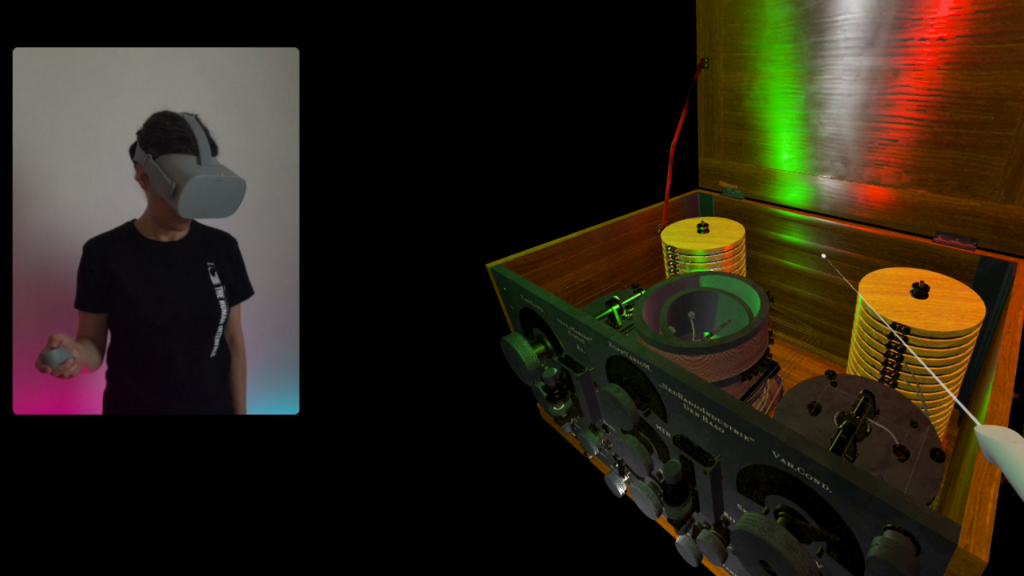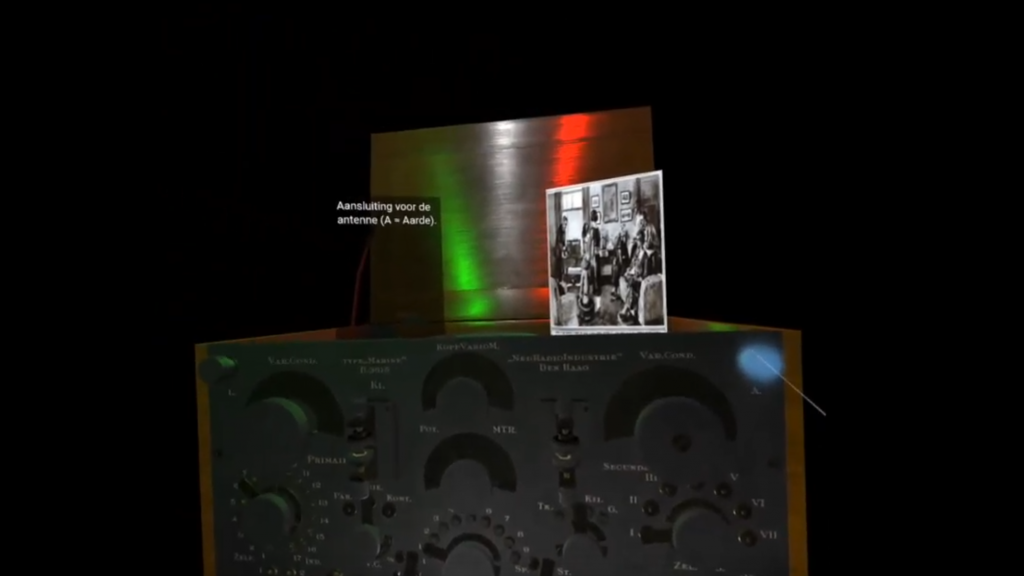Visualizing a radio of the past using technology of the future
A researcher from the Virtual Interiors Project, Hugo Huurdeman, was embedded at Sound & Vision for several months, working on a concept for an interactive 3D experience of historical radios. Take a look at how this exploratory project showed the potential of creating a virtual representation of a radio from the past.
A researcher from the Virtual Interiors Project, Hugo Huurdeman, was embedded at Sound & Vision for several months, working on a concept for an interactive 3D experience of historical radios. Take a look at how this exploratory project showed the potential of creating a virtual representation of a radio from the past.

Guest post by Hugo Huurdeman
Interactive environments
The project Virtual Interiors as Interfaces for Big Historical Data creates new types of 2D, 3D and 4D interfaces to access historical and linked data. Within the project, virtual reconstructions of historical rooms in different 17th century houses are created. These 3D models can provide access to extensive research, historical information and various archival documents.
Because of its interest in the preservation of 3D media and the presentation of its archives in 3D, interactive environments, the Netherlands Institute for Sound & Vision is a partner in the Virtual Interiors project. Sound & Vision has a large collection of historical media-related objects, such as radios and televisions. These objects are sometimes displayed in the museum, but often not visible to the public. When they are displayed, it is behind glass with limited clarity about how the device works.

The Marine B radio receiver (1920)
The Marine B radio receiver
"We would like to express our great satisfaction with the receiver type Marine B 2477, which you delivered 12 years ago. During all this time (day and night), this receiver has been in use, an achievement which speaks by itself". A highly satisfied client wrote this in a letter to ir. Hans Idzerda on 29 October 1931. The Marine B radio, an early crystal radio receiver, was designed and built by the firm Nederlandse Radio Industrie (NRI), founded by Hans Idzerda in the Hague.

Portrait of Hans Schotanus à Scheringa Idzerda (1919)
Pioneer
Idzerda was a true pioneer in the field of radio broadcasting, conducting the first radio broadcast in the Netherlands in 1919. For our project, we took the Marine B radio (1920) from the collections at Sound & Vision as a basis, an example of the design and craftsmanship of Idzerda's creations.

Renders of the 3D model of the Marine B
Creating an interactive 3D experience for the Marine B radio
In a first step, the Marine B radio, as well as contemporary headphones, were recreated as 3D models by the Dutch company Tijdlab. Subsequently, these were used as a basis for constructing an interactive 3D application for the Web using BabylonJS, which could be viewed via a variety of platforms, ranging from regular PCs to touch-screen based devices and even Virtual Reality headsets.

Renders of the 3D model of the headphones
Information and metadata about the radio and its components were all entered in an online spreadsheet, using information from initial conversations with radio experts Rob de Bie and Ed Plevier. Utilizing the data gathered in the online spreadsheet, the interactive application could load the 3D models and display information about the various radio components from the online spreadsheet side-by-side.

Idzerda virtual radio - prototype 1
Idzerda virtual radio - prototype 1
This video above shows the first prototype application we created. It allows for investigating the Marine B from various viewing positions (outside and inside the radio), to get informed about each component, to experiment with lighting settings, and to follow a guided tour informing about the functionality of the radio. Since this prototype did not take advantage of the surroundings of the radio, nor from the possibilities that Virtual Reality has to offer, we continued working on a second prototype.

Idzerda virtual radio - prototype 2
Idzerda virtual radio - prototype 2
This second video shows how we further optimized our second prototype for use in immersive VR, providing playful ways to de- and reconstruct the virtual radio piece by piece. Moreover, we added various surroundings, such as a schematic living room, and a mock-up ship environment. Embedding the 3D radio within an environment can increase the sense of scale, but also offers the possibility to directly interact with additional contextual information, such as the letter by a thankful customer referenced above, or a portrait of Idzerda on the wall.
Lessons learned
Related to presentation, we observed that different viewing platforms can provide unique possibilities: the PC-based platform facilitates exchanging detailed information about the radio itself, while phones and tablets allow for emphasis of the tactile qualities of the radio. Moreover, Virtual Reality can reveal the real dimensions of the object in an immersive experience and invites for playful approaches to interaction. We learned to use a “scalable” approach: use the same contextual information where possible, but add specific functionality tailored to specific viewing mode. For instance, the full texts and annotation possibilities in the PC mode, and abbreviated texts and custom navigation possibilities within the environment in the VR mode.
In terms of preservation, we combined open file formats for 3D models (such as GLTF), with open-source software for presentation (BabylonJS) and structured spreadsheets for contextual background information. This approach facilitates archiving all included software and dependencies, enabling preserving and recreating the experience in the future, for instance via emulation. We found the flexibility of the used open-source web framework especially valuable, as it scales across platforms and supports common standards such as WebXR. The separation between 3D models, and separately editable contextual information allows for direct collaboration between people with different expertises, including the 3D modelers, interaction designers and historical experts.
Conclusion and future work
This exploratory project showed the potential of creating a virtual representation of a radio from the past. This opens up possibilities which are not feasible with a "real" historical radio, such as handling and removing components, as well as getting analytical overviews. One can play with perspectives: a standard view of the radio from the outside, but also a "miniature" view to explore the radio from the inside. Moreover, one can place the radio in different environments, for instance a living room or ship, and provide additional context within this space, for instance the letter thanking Idzerda for the high quality radio he constructed.
Thus, we highlighted the feasibility and value of creating an interactive 3D representation. Such an interactive 3D experience could be very worthwhile for research, educational and professional use, but also for engaging broader audiences. As various types of historical objects often cannot be exhibited due to their fragility, our approach may be valuable for further archival objects. A potential hindrance is the cost of manually creating detailed 3D models, but we are also looking at other semi-automatic ways to do 3D modeling, such as photogrammetry. The presented interactive 3D prototypes are developed further within the Virtual Interiors Project and tested with users. Also, we plan to extend the explorations already done by making Idzerda's historical radio available in Augmented Reality.
Try out the experimental viewer of Idzerda's Marine B
Hugo Huurdeman is a postdoctoral researcher at the Media Studies department of the University of Amsterdam. He is involved in the Virtual Interiors project.
Acknowledgements: this work was conducted in the context of the project 'Virtual Interiors as Interfaces for Big Historical Data Research. Spatially enhanced publications of the creative industries of the Dutch Golden Age' funded by the Dutch Research Council (NWO).
